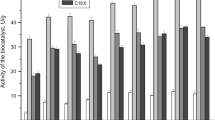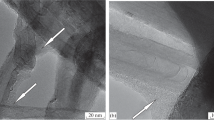Abstract
A novel support has been utilized for immobilization of lipase, which was prepared by amination of silica with ethanolamine followed by cross linking with glutaraldehyde. Lipases from Rhizopus oryzae3562 and Enterobacter aerogenes were immobilized on activated silica gel, where they retained 60 and 50% of respective original activity. The thermal stability of the immobilized lipases was significantly improved in comparison to the free forms while the pH stability remained unchanged. E. aerogenes and R. oryzae3562 lipases retained 75 and 97% of respective initial activity on incubation at 90 °C, whereas both the free forms became inactive at this temperature. The conversion yield of isoamyl acetate was found to be higher with the immobilized fungal (90 vs. 21%) and bacterial lipases (64 vs. 18%) than the respective free forms. Immobilized R. oryzae3562 lipases retained 50% activity for isoamyl acetate synthesis up to ten cycles whereas it was eight cycles for E. aerogenes.












Similar content being viewed by others
References
Rizzi M, Stylos P, Rieck A, Reuss MA (1992) A kinetic study of immobilized lipase catalysing the synthesis of isoamyl acetate by transesterification in n-hexane. Enzyme Microb Technol 14:709–714
Vulfson EN (1994) Lipases––their structure. In: Woolley P, Peterson SB (eds) Biochemistry and Applications. Cambridge University Press, Cambridge, pp 271–288
Welsh FW, Murray WD, Williams RE (1989) Microbiological and enzymatic production of flavor and fragrance chemicals. Crit Rev Biotechnol 9:105–169
Cao L, Langen LV, Sheldon RA (2003) Immobilized enzymes: carrier-bound or carrier free? Curr Opin Biotechnol 14:387–394
Khare SK, Nakajima M (2000) Immobilization of Rhizopus japonicus lipase on celite and its application for enrichment of docosahexaenoic acid in soybean oil. Food Chem 68:153–157
Bagi K, Simon LM, Szajani B (1997) Immobilization and characterization of porcine pancreas lipase. Enzyme Microb Technol 20:531–535
Kim MIl, Ham HO, Oh S-D, Park HG, Chang HN, Choi S-H (2006) Immobilization of Mucor javanicus lipase on effectively functionalized silica nanoparticles. J Mol Catal, B Enzym 39:62–68
Hwang S, Lee K-T, Park J-W, Min B-R, Haam S, Ahn I-S, Jung J-K (2004) Stability analysis of Bacillus stearothermophilus L1 lipase immobilized on surface-modified silica gels. Biochem Eng J 17:85–90
Balcão VM, Paiva AL, Malcata FX (1996) Bioreactors with immobilized lipases: state of the art. Enzyme Microb Technol 18:392–416
Bryjak J, Bachmann K, Pawlow B, Maliszewska I, Trochimczuk A, Kolarz BN (1997) Immobilization of lipase on various acrylic copolymers. Chem Eng J 65:249–256
Kilinç A, Önal S, Telefoncu A (2002) Chemical attachment of porcine pancreatic lipase to crosslinked poly(vinyl alcohol) by means of adipoyldichloride. Process Biochem 38:641–647
Klibanov AM (2001) Improving enzymes by using them in organic solvents. Nature 409:241–246
Persson M, Mladenoska I, Wehtje E, Adlercreutz P (2002) Preparation of lipases for use in organic solvents. Enzyme Microb Technol 31:833–841
Zhao XS, Bao XY, Guo W, Lee FY (2006) Immobilizing catalysts on porous materials. Materialstoday 9:32–39
Novak Z, Habulin M, Krmelj V, Knez Ž (2003) Silica aerogels as supports for lipase catalyzed esterifications at sub- and supercritical conditions. J Supercrit Fluids 27:169–178
Rao MN, Kembhavi AA, Pant A (2000) Immobilization of endo-polygalacturonase from Aspergillus ustus on silica gel. Biotechnol Lett 22:1557–1559
Bruins ME, Janssen AEM, Boom RM (2001) Thermoenzymes and their applications. Appl Biochem Biotechnol 90:155–186
Gupta MN (1991) Thermostabilization of proteins. Biotechnol Appl Biochem 14:1–11
Mateo C, Abian O, Fernandez-Lafuente R, Guisan JM (2000) Increase in conformational stability of enzymes immobilized on epoxy-activated supports by favoring additional multipoint covalent attachment. Enzyme Microb Technol 26:509–515
Petzelbauer I, Kuhn B, Splechtna B, Kulbe KD, Nidetzky B (2002) Development of and ultrahigh temperature process for the enzymatic hydrolysis of lactose. IV. Immobilization of two thermostable β-glycosidases and optimization of a packed-bed reactor for lactose conversion. Biotechnol Bioeng 77:619–631
Matsumoto M, Kondo K (2001) Enhanced thermostability of α-chymotrypsin enclosed in inorganic microcapsules. J Biosci Bioeng 92:197–199
Sharma S, Gupta MN (2001) Alginate as a macroaffinity ligand and an additive for enhanced activity and thermostability of lipases. Biotechnol Appl Biochem 33:161–165
Cheetham PSJ (1995) The applications of enzymes in industry. In: Wiseman A (eds) Handbook of enzyme biotechnology. Ellis Horwood, UK, pp 419–522
Hölker U, Höfer M , Lenz J (2004) Biotechnological advantages of laboratory-scale solid-state fermentation with fungi. Appl Microbiol Biotechnol 64:175–186
Kordel M, Hofmann B, Schomburg D, Schmid RD (1991) Ex-tracellular lipase of Pseudomonas sp. strain ATCC-21808, purification, characterization, crystallization, and preliminary X-ray diffraction data. J Bacteriol 73:483–484
Lowry OH, Rosebrough NJ, Farr AL, Randall RJ (1951) Protein measurement with the folin phenol reagent. J Biol Chem 193:265–275
Esawy MA, Combet-Blanc Y (2006) Immobilization of Bacillus licheniformis 5A1 milk-clotting enzyme and characterization of its enzyme properties. World J Microbiol Biotechnol 22:197–200
Ghamgui H, Karra-Chaâbouni M, Gargouri Y (2004) 1-Butyl oleate synthesis by immobilized lipase from Rhizopus oryzae: a comparative study between n-hexane and solvent-free system. Enzyme Microb Technol 35:355–363
Nawani N, Singh R, Kaur J (2006) Immobilization and stability studies of a lipase from thermophilic Bacillus sp: the effect of process parameters on immobilization of enzyme. Electron J Biotechnol 9:DOI: 10.2225/vol9-issue5-fulltext-9
Gottschalk N, Jaenicke R (1991) Authenicity and reconstitution of immobilised enzymes characterisation denaturation renaturation of glucoamylase. Biotechnol Appl Biochem 14:324–335
Krajewska B, Leszko M, Zaboraska W (1990) Urease immobilised on chitosan membrane: preparation and properties. J Chem Tech Biotechnol 48:337–350
Martinek K, Kilbanov AM, Goldmacher VS, Berezin IV (1977) The principles of enzyme stabilization. Biochim Biophys Acta 485:1–12
Chiou S-H, Wu W-T (2004) Immobilization of Candida rugosa lipase on chitosan with activation of the hydroxyl groups. Biomaterials 25:197–204
Klibanov AM (1979) Enzyme stabilization by immobilization. Anal Biochem 93:1–25
Matsumoto M, Ohashi K (2003) Effect of immobilization on thermostability of lipase from Candida rugosa. Biochem Eng J 14:75–77
He F, Zhuo RX, Liu LJ, Jin DB, Feng J, Wang XL (2001) Immobilized lipase on porous silica beads: preparation and application for enzymatic ring-opening polymerization of cyclic phosphate. React Funct Polym 47:153–158
Iborra JL, Castellar MR, Cánovas M, Manjón A (1992) Picrocrocin hydrolysis by immobilized fi-glucosidase. Biotechnol Lett 14:475–480
Ye P, Xua Z-K, Che A-F, Wub J, Seta P (2005) Chitosan-tethered poly (acrylonitrile-co-maleic acid) hollow fiber membrane for lipase immobilization. Biomaterials 26:6394–6403
Li S, Hu J, Liu B (2004) Use of chemically modified PMMA microspheres for enzyme immobilization. BioSystems 77:25–32
Krishna SH, Divakar S, Prapulla SG, Karanth NG (2001) Enzymatic synthesis of isoamyl acetate using immobilized lipase from Rhizomucor miehei. J Biotechnol 87:193–201
Romeroa MD, Calvoa L, Albaa C, Daneshfarb A, Ghaziaskarb HS (2005) Enzymatic synthesis of isoamyl acetate with immobilized Candida antarctica lipase in n-hexane. Enzyme Microb Technol 37:42–48
Melo LLMM, Pastore GM, Macedo GA (2005) Optimized synthesis of citronellyl flavour esters using free and immobilized lipase from Rhizopus sp. Process Biochem 40:3181–3185
Carta G, Gainer JL, Benton AH (1991) Enzymatic synthesis of esters using an immobilized lipase. Biotechnol Bioeng 37:1004–1009
Desai PD, Dave AM, Devi S (2006) Alcoholysis of salicornia oil using free and covalently bound lipase onto chitosan beads. Food Chem 95:193–199
Hung T-C, Giridhar R, Chiou S-H, Wu W-T (2003) Binary immobilization of Candida rugosa lipase on chitosan. J Mol Catal, B Enzym.26:69–78
Acknowledgments
The authors wish to acknowledge CSIR, Government of India and Department of Biotechnology, India for providing research fellowship to Annapurna Kumari and Paramita Mahapatra, respectively.
Author information
Authors and Affiliations
Corresponding author
Rights and permissions
About this article
Cite this article
Kumari, A., Mahapatra, P., Kumar, G.V. et al. Comparative study of thermostabilty and ester synthesis ability of free and immobilized lipases on cross linked silica gel. Bioprocess Biosyst Eng 31, 291–298 (2008). https://doi.org/10.1007/s00449-007-0160-x
Received:
Accepted:
Published:
Issue Date:
DOI: https://doi.org/10.1007/s00449-007-0160-x




